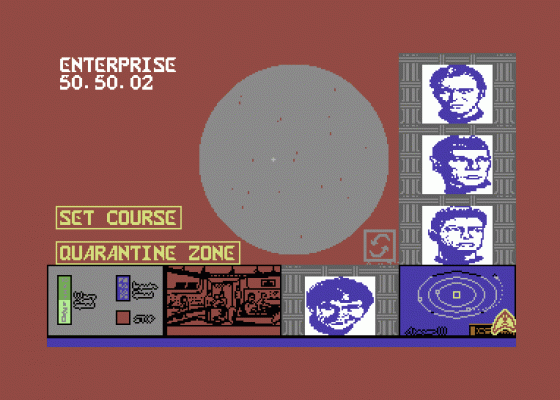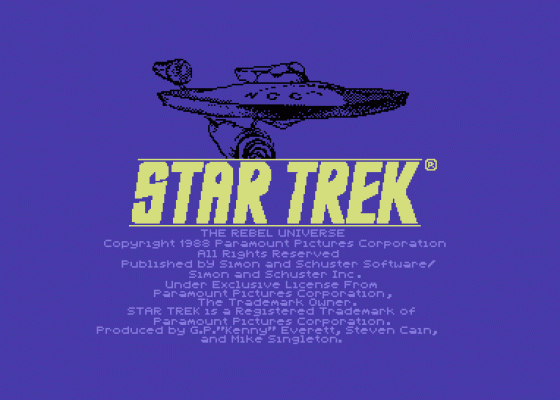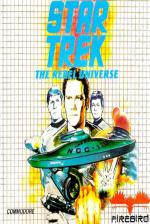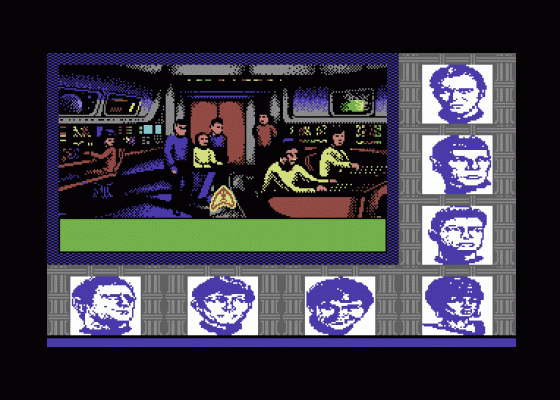
Computer Gamer
 1st April 1987
1st April 1987
Publisher: Firebird
Machine: Commodore 64
Published in Computer Gamer #25
Star Trek: The Rebel Universe
Space, the final frontier. These are the computer adventures of the starship Enterprise as it boldly goes where no game has gone before.
Forget the previous, forget the rumours, Star Trek is finally ready to beam down on the Atari ST. At last, trekies get their chance to command the Enterprise, go to Warp Factor Ten and battle Romulans and Klingons in glorious galactic dogfights. And it all comes in equally glorious technicolour digitised graphics accompanied by stunning sound effects.
Captain James T. Kirk himself sets the scene as he tells you, again, that space is the final frontier. This is followed by a fair rendition of the Star Trek theme, then the bridge fills the screen and you're ready to take command.

Programmer Mike (Lords Of Midnight) Singleton has resisted the temptation to base the game on a single film or TV episode - even though the latest film, Star Trek IV, is imminent. Instead, he has created a scenario that highlights the military and explorative strengths of the Enterprise.
It seems that in the last few months, twenty Federation ships have gone renegade, switching their allegiance to Klingons. All the action is taking place in a sector of space centred around the star Dakiak which the Federation has now sealed off, using a Klien Sphere, after it calculated that the rate of spread of the mutiny would mean the entire Federation would be affected in a few months. Just before the Sphere is closed, the Enterprise is sent in to find out what has happened, bring the renegades back into the fold and save the 1,000 stars that will become isolated forever should Kirk and co. fail.
As expected, the Klingons are the cause of the rebellion - they are emitting psi-beams and telepathically controlling the 'renegades' from their base on an energy-refining planet near the centre of the Sphere.

The Klingon admiral is aware that the Federation is constructing a Klien Sphere but is carrying on regardless as, if his plans succeeds, the Klingons will be able to take over the universe.
To add to the Enterprise's problems, there are also Romulan planets trapped in the Sphere so you will have to fight off Romulan ships as well as the Klingon and rebel starships!
The game features yet another amazing Mike Singleton system - remember his landscaping in Lords Of Midnight that created thousands of views? Now he's created 'multivision'; this consists of a main screen, which occupies three quarters of the display, surrounded by seven mini screens. Using these screens, you must control the Enterprise, explore the 1,000 star quarantine zone locked in the Klien Sphere, and stop the Klingon experiment. OK!

The bridge is the main control area and you can get to any controls by clicking your Federation symbol cursor over the responsible crew member. Selecting Kirk allows you to inspect the ships stores for artifacts and to choose a landing party. Spock analyses planets and gives you damage reports, Sulu controls navigation and Chekov mans the weapon systems. Inured crew members recover in Dr. McCoy's sick bay. Uhura takes messages from Starfleet command and special archive planets and, finally, Scottie reports on the state of Warp and Impulse Drives.
Your first job is to select Sulu's controls and plot a course to a star in the Sphere. Then you select Spock, who reports on the size and alignment of the star system - for example, Klingon, six planets. The engine screen allows you to select warp speed. At Warp Ten, a digitised Scottie voice warns you that: "If you carry on at this speed, she'll blow up, cap'n," so you reduce to Warp Factor Eight.
A ping announces your arrival in the relevant star system and produces a system map. Click each planet and Spock will isolate the planets that are life-supporting, which are the only ones you can beam down to. Select Impulse power and you'll soon be in orbit around your chosen planet - the main screen fills with an impressive picture of the Enterprise in orbit. Kirk can then select six of the seven main crew members to beam down to the planet's surface.

Down on the planet, the landing party will meet anything from a stubborn door that won't open, to humble janitor robots, and superior intelligences that could wipe out the Enterprise with a single thought. On the surface, the screen display is disappointing, however, as it consists only of the heads of the landing party and a line drawing of the object in their path.
You are now faced with a mini-adventure sequence in which you must get past locked doors, robots and forcefields to gain a useful object that can then be beamed up to the Enterprise's store room. Whatever the problem, each crew member will have their own way of dealing with it. For example, Kirk will look for hidden switches, Spock will try to decode. Sulu will fire his phasor at it and Chekov will kick it - it may be better to leave Chekov on the Enterprise. A control bar at the top of the screen will report reaction to these activities - nothing, it worked or a crew man is injured and so on until you either complete the sequence or you have to beam back to the Enterprise to let your landing party recover in the sick bay.
Some of the objects that you find can be installed into the Enterprise to make it more efficient, such as Cherenkov crystals that extend the life of your valuable dilithium crystals, and synapse bombs that wipe out any Klingons in the system.
Next a loud red alert klaxxon announces the arrival of enemy ships that can be plotted through Chekov's Elite style display. The Enterprise appears in the centre of the revolving scanner with any approaching ship marked as a 'T' with the height of the T reflecting altitude.
If you're on a planet you'd better beam back to the ship, select some impulse power, to give you some "room" to manoeuvre, and then select either phasors or photon torpedoes. The approaching craft will then show up as a vector graphics drawing on Chekov's battle screen which you must lock onto using a red targeting circle. This circle decreases in size the closer you get to your opponent and marks the area your shots will randomly hit. If the circle is large and engulfs the whole ship then you're likely to miss, whereas a small circle surrounded by the ship will guarantee a hit. Destroying the enemy may take lots of hits, depending on where you attack - a shot to the bridge is more effective than a blow to an engine or one of the decks. Selecting Spock will give you details of the enemy's damage as well as your own.
The mark of a good captain is knowing when to fight and when to warp out of trouble, which you can do if you can get to Sulu's controls in time. It is also imporant to scout out repair docks and friendly planets to replace your energy, dilithium crystals and torpedo stores. Lose too much of any of these and the game will end with the destruction of the Enterprise and a raised eyebrow from Spock.
Some of the planets you encounter are harmful, but some can help you by shielding you from Klingon scanners or healing your injured crew. The curious archive planets will beam important clues that can be picked up by Uhura.
Star Trek is a massive game in which you must explore a system that contains 1,000 stars around which are 256 life-supporting planets to explore. Initially, you should keep to the outer parts of the Sphere as the main Klingon and Romulan forces patrol the centre. This will give you a chance to map out the necessary repair planets before you delve deeper.
Although the screen display shows eight different screens - the main one and seven mini screens that can be accessed by clicking them - these may not include the ones you need. Therefore, it helps to punch up Chekov's displays and the system maps so you're ready to react quickly in case you are ambushed.
The action is accompanied by digitised speed and sound effects, such as the red alert alarm, and the transporter beam. These add tremendously to the atmosphere and appeal of the game.
Beyond promises other versions later, which are likely to be similar as the game uses mainly static screens without too much fast action that would be slowed down by lesser machines. Not many machines could match the painterly quality of this ST version but the C64 could come close. But until Beyond - or others, do the conversion work, trekkies can only look on with envy unless, of course, they rush out and buy an Atari ST. They won't be disappointed with this guaranteed number one hit.



